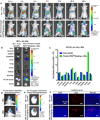Affinity-controlled protein encapsulation into sub-30 nm telodendrimer nanocarriers by multivalent and synergistic interactions
- PMID: 27294543
- PMCID: PMC4921341
- DOI: 10.1016/j.biomaterials.2016.06.006
Affinity-controlled protein encapsulation into sub-30 nm telodendrimer nanocarriers by multivalent and synergistic interactions
Abstract
Novel nanocarriers are highly demanded for the delivery of heterogeneous protein therapeutics for disease treatments. Conventional nanoparticles for protein delivery are mostly based on the diffusion-limiting mechanisms, e.g., physical trapping and entanglement. We develop herein a novel linear-dendritic copolymer (named telodendrimer) nanocarrier for efficient protein delivery by affinitive coating. This affinity-controlled encapsulation strategy provides nanoformulations with a small particle size (<30 nm), superior loading capacity (>50% w/w) and maintained protein bioactivity. We integrate multivalent electrostatic and hydrophobic functionalities synergistically into the well-defined telodendrimer scaffold to fine-tune protein binding affinity and delivery properties. The ion strength and density of the charged groups as well as the structure of the hydrophobic segments are important and their combinations in telodendrimers are crucial for efficient protein encapsulation. We have conducted a series of studies to understand the mechanism and kinetic process of the protein loading and release, utilizing electrophoresis, isothermal titration calorimetry, Förster resonance energy transfer spectroscopy, bio-layer interferometry and computational methods. The optimized nanocarriers are able to deliver cell-impermeable therapeutic protein intracellularly to kill cancer cells efficiently. In vivo imaging studies revealed cargo proteins preferentially accumulate in subcutaneous tumors and retention of peptide therapeutics is improved in an orthotopic brain tumor, these properties are evidence of the improved pharmacokinetics and biodistributions of protein therapeutics delivered by telodendrimer nanoparticles. This study presents a bottom-up strategy to rationally design and fabricate versatile nanocarriers for encapsulation and delivery of proteins for numerous applications.
Keywords: Affinity-controlled encapsulation; Multivalent interactions; Nanoparticles; Protein delivery; Synergistic effects; Telodendrimers.
Copyright © 2016 Elsevier Ltd. All rights reserved.
Figures






Similar articles
-
Riboflavin-containing telodendrimer nanocarriers for efficient doxorubicin delivery: High loading capacity, increased stability, and improved anticancer efficacy.Biomaterials. 2017 Oct;141:161-175. doi: 10.1016/j.biomaterials.2017.06.041. Epub 2017 Jun 30. Biomaterials. 2017. PMID: 28688287 Free PMC article.
-
Fine-tuning vitamin E-containing telodendrimers for efficient delivery of gambogic acid in colon cancer treatment.Mol Pharm. 2015 Apr 6;12(4):1216-29. doi: 10.1021/acs.molpharmaceut.5b00051. Epub 2015 Mar 2. Mol Pharm. 2015. PMID: 25692376 Free PMC article.
-
Zwitterionic Janus Dendrimer with distinct functional disparity for enhanced protein delivery.Biomaterials. 2019 Sep;215:119233. doi: 10.1016/j.biomaterials.2019.119233. Epub 2019 May 31. Biomaterials. 2019. PMID: 31176068 Free PMC article.
-
Telodendrimer-based nanocarriers for the treatment of ovarian cancer.Ther Deliv. 2013 Oct;4(10):1279-92. doi: 10.4155/tde.13.91. Ther Deliv. 2013. PMID: 24116912 Free PMC article. Review.
-
Multifunctional nanocarriers for simultaneous encapsulation of hydrophobic and hydrophilic drugs in cancer treatment.Nanomedicine (Lond). 2014 Jul;9(10):1499-515. doi: 10.2217/nnm.14.97. Nanomedicine (Lond). 2014. PMID: 25253498 Review.
Cited by
-
Polycation-telodendrimer nanocomplexes for intracellular protein delivery.Colloids Surf B Biointerfaces. 2018 Feb 1;162:405-414. doi: 10.1016/j.colsurfb.2017.12.021. Epub 2017 Dec 12. Colloids Surf B Biointerfaces. 2018. PMID: 29247913 Free PMC article.
-
Telodendrimers: Promising Architectural Polymers for Drug Delivery.Molecules. 2020 Sep 2;25(17):3995. doi: 10.3390/molecules25173995. Molecules. 2020. PMID: 32887285 Free PMC article. Review.
-
Combinatorial approaches in post-polymerization modification for rational development of therapeutic delivery systems.Acta Biomater. 2018 Jun;73:21-37. doi: 10.1016/j.actbio.2018.04.010. Epub 2018 Apr 12. Acta Biomater. 2018. PMID: 29654990 Free PMC article. Review.
-
Electrostatically Driven Guanidinium Interaction Domains that Control Hydrogel-Mediated Protein Delivery In Vivo.ACS Cent Sci. 2019 Nov 27;5(11):1750-1759. doi: 10.1021/acscentsci.9b00501. Epub 2019 Oct 18. ACS Cent Sci. 2019. PMID: 31807676 Free PMC article.
-
Multifunctional Telodendrimer Nanocarriers Restore Synergy of Bortezomib and Doxorubicin in Ovarian Cancer Treatment.Cancer Res. 2017 Jun 15;77(12):3293-3305. doi: 10.1158/0008-5472.CAN-16-3119. Epub 2017 Apr 10. Cancer Res. 2017. PMID: 28396359 Free PMC article.
References
-
- Leader B, Baca QJ, Golan DE. Protein therapeutics: a summary and pharmacological classification. Nat. Rev. Drug. Discov. 2008;7:21–39. - PubMed
-
- Wang C-Y, Mayo MW, Baldwin AS. TNF-and cancer therapy-induced apoptosis: potentiation by inhibition of NF-κB. Science. 1996;274:784–787. - PubMed
-
- Chen J, Zhao M, Feng F, Sizovs A, Wang J. Tunable thioesters as “reduction” responsive functionality for traceless reversible protein PEGylation. J. Am. Chem. Soc. 2013;135:10938–10941. - PubMed
-
- Liu M, Johansen P, Zabel F, Leroux J-C, Gauthier MA. Semi-permeable coatings fabricated from comb-polymers efficiently protect proteins in vivo. Nat. Commun. 2014;5:5526. - PubMed
-
- Kobsa S, Saltzman WM. Bioengineering approaches to controlled protein delivery. Pediatr. Res. 2008;63:513–519. - PubMed
Publication types
MeSH terms
Substances
Grants and funding
LinkOut - more resources
Full Text Sources
Other Literature Sources

